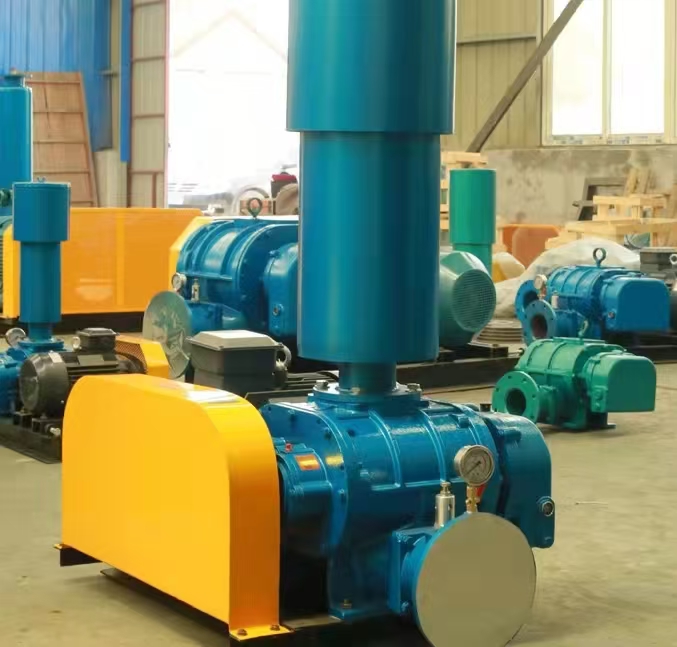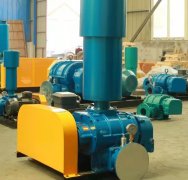The pressure range of Roots blowers varies depending on their design and application scenarios, usually divided into * * conventional working pressure * * and * * ultimate pressure * *. The following are detailed classifications and explanations:
---

**1、 Standard pressure range of Roots blower**
1. * * Single stage Roots blower * * (most common)
-* * Normal work pressure * *:
**9.8~58.8 kPa**(0.1~0.6 Bar)
-* * Typical applications * *: Sewage treatment aeration, pneumatic conveying, aquaculture, etc.
-High Voltage Improved Type:
**58.8~78.4 kPa**(0.6~0.8 Bar)
-* * Features * *: Requires strengthened gears and bearings, suitable for short-term high-pressure requirements (such as vacuum feeding).
2. * * Double stage series Roots blower**
-* * Normal work pressure * *:
**98~137 kPa**(1.0~1.4 Bar)
-* * Typical applications * *: High pressure scenarios such as industrial blowback and special gas compression.
-Ultimate pressure:
≤ 147 kPa (1.5 Bar, short-term operation).
---
**2、 Key factors of pressure limitation**
1. * * Structural materials**
-Cast iron shell: pressure bearing ≤ 0.8 Bar (long-term operation).
-Steel shell: up to 1.5 Bar (customized model, higher cost).
2. * * Rotor sealing performance**
-When the pressure is greater than 0.6 Bar, the rotor clearance should be ≤ 0.15mm, otherwise the leakage will significantly increase.
3. * * Temperature rise issue**
-For every 0.1 bar increase in pressure, the outlet temperature increases by 10-15 ℃, and the cooling system needs to be monitored.
---
**3、 Selection suggestions**
|* * Demand Pressure * * | * * Recommended Fan Types * * | * * Precautions * *|
|--------------------|-----------------------|----------------------------------|
|≤ 0.6 Bar | Single stage standard Roots blower | Cost effective, easy maintenance|
|0.6~0.8 Bar | Single stage high-pressure Roots blower | Need to strengthen lubrication and cooling|
|0.8~1.4 Bar | Double stage series Roots blower | High energy consumption, suitable for intermittent high-pressure working conditions|
|1.4 Bar | Screw fan/centrifugal compressor | Roots blower is uneconomical and inefficient|
---
**4、 Practical application cases**
1. * * Sewage treatment * *: Typically, a single-stage fan with a capacity of 49 kPa (0.5 Bar) is used.
2. * * Flour mill pneumatic conveying * *: requires * * 68.6 kPa * * (0.7 Bar) high-pressure single-stage model.
3. * * Chemical Backblowing System * *: Adopting a two-stage fan * * 117.6 kPa * * (1.2 Bar).
---
**5、 Important precautions**
-* * Strictly prohibit overpressure operation * *:
Pressure exceeding the nameplate value by 10 may cause rotor collision and bearing damage.
-* * Valve must be installed * *:
Set the pressure to 1.1 times the rated value (e.g. 0.66 Bar pressure relief for a 0.6 Bar fan).
-* * Pressure measurement point * *:
According to the pressure gauge at the outlet flange of the fan, the pressure loss of the pipeline needs to be calculated separately.
---
**6、 Common Misconceptions and Answers**
-Misconception: "Increasing the rotational speed can increase pressure
**Fact * *: The pressure of the Roots blower is determined by the system back pressure, and increasing the speed only increases the air volume, which may actually lead to motor overload.
-Misconception: "A two bladed fan has higher pressure than a three bladed fan
**Fact * *: The number of blades affects efficiency and noise, regardless of pressure.
---
**Summary**
The conventional pressure range of Roots blower is 0.1~0.8 Bar (single-stage) or 1.0~1.4 Bar (two-stage). When selecting, it is necessary to choose based on the actual system resistance (total pressure loss of pipelines, valves, and equipment), and reserve 10-20 margins. If the demand exceeds 1.4 Bar, it is recommended to use other compression equipment (such as screw fans) instead.



